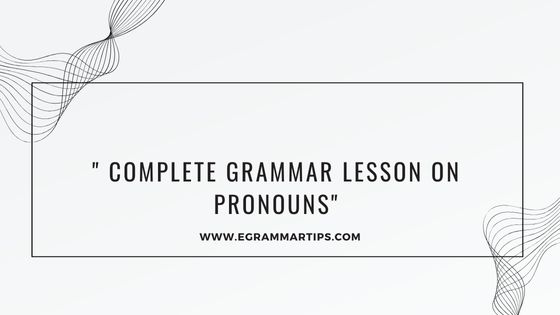
1. Introduction to Pronouns:
Pronouns are words that take the place of nouns in a sentence. They help to avoid repetition and make sentences clearer and more concise. For example, instead of saying “John went to John’s house,” you would say, “John went to his house,” where “his” is the pronoun replacing “John’s.”
Key Types of Pronouns:
- Personal Pronouns
- Possessive Pronouns
- Reflexive Pronouns
- Demonstrative Pronouns
- Interrogative Pronouns
- Relative Pronouns
- Indefinite Pronouns
- Intensive Pronouns
- Reciprocal Pronouns

2. Personal Pronouns
Personal pronouns refer directly to specific people or things. They are divided into subject pronouns and object pronouns.
Subject Pronouns:
•First Person: I, We
•Second Person: You
•Third Person: He, She, It, They
Example: She is going to the market.
Object Pronouns:
•First Person: Me, Us
•Second Person: You
•Third Person: Him, Her, It, Them
Example: The teacher called him.
Note: Subject pronouns are used as the subject of a verb, while object pronouns are used as the object of a verb or preposition.
3. Possessive Pronouns
Possessive pronouns show ownership or possession. They replace nouns to indicate that something belongs to someone.
Examples:
•First Person: Mine, Ours
•Second Person: Yours
• Third Person: His, Hers, Its, Theirs
Example: This book is mine.
Difference from Possessive Adjectives: Possessive pronouns stand alone, whereas possessive adjectives (my, your, his, her, its, our, their) modify nouns directly.
4. Reflexive Pronouns
Reflexive pronouns are used when the subject and the object of a sentence are the same person or thing. They end in “-self” (singular) or “-selves” (plural).
Examples:Myself, Yourself, Himself, Herself, Itself, Ourselves, Yourselves, Themselves
Example: She prepared herself for the exam.
Usage Tip: Reflexive pronouns are essential in sentences where the subject acts on itself. Avoid using reflexive pronouns where a personal pronoun (me, you, him, her, it, us, them) is required.
5. Demonstrative Pronouns
Demonstrative pronouns are used to point to specific things. The most common demonstrative pronouns are this, that, these, and those.
Examples:
° This is my favorite book. (This points to a singular object close to the speaker.)
° Those are her shoes. (Those points to plural objects far from the speaker.)
Usage Tip: Demonstrative pronouns replace nouns, while demonstrative adjectives modify nouns (e.g., this book vs. this).
6. Interrogative Pronouns
Interrogative pronouns are used to ask questions. The main interrogative pronouns are who, whom, whose, which, and what.
Examples:
•Who is coming to the party?
•Which of these options is correct?
Who vs. Whom:Who is used as a subject (e.g., Who called?).
Whom is used as an object (e.g., To whom did you speak?).
7. Relative Pronouns
Relative pronouns introduce relative clauses and link them to the main clause. They include who, whom, whose, which, and that.
Examples:
•The man who called is my brother.
• This is the book that I was reading.
Usage Tip: Relative pronouns must agree with their antecedent in number and person.
For example, “The person who helped me was very kind” (singular subject).
8. Indefinite Pronouns
Indefinite pronouns refer to non-specific people or things. Common indefinite pronouns include someone, anyone, everyone, no one, something, anything, nothing, all, some, few, many, and several.
Examples:Someone left their bag here.Many were called, but few were chosen.
Agreement Tip: Indefinite pronouns can be singular or plural, affecting verb agreement.
For instance,
“Everyone is invited” (singular) vs. “Many are coming” (plural)
9. Intensive Pronouns
Intensive pronouns are used to emphasize another noun or pronoun. They are identical in form to reflexive pronouns but serve a different function.
Examples:
•The president himself announced the news.
•She did it herself.
Usage Tip: Intensive pronouns can be removed without changing the meaning of the sentence.
10. Reciprocal Pronouns
Reciprocal pronouns express a mutual action or relationship. The two reciprocal pronouns are each other and one another.
Examples:
•The two friends hugged each other.
•They respect one another.
Usage Tip: “Each other” typically refers to two people, while “one another” is used for three or more
11. Pronoun Agreement
Pronouns must agree with their antecedents in number, gender, and person. This is known as pronoun-antecedent agreement.
Examples:
•Singular antecedent: The student forgot his or her book. (singular pronoun)
•Plural antecedent: The students forgot their books. (plural pronoun)
Common Issues:
•Vague Reference: Ensure the pronoun clearly refers to a specific noun. For example, “When Jake met Tom, he was happy” is ambiguous—who was happy?
•Agreement with Indefinite Pronouns: Indefinite pronouns like “everyone” are singular, so use singular pronouns (e.g., “Everyone has his or her own opinion”).
12. Common Pronoun Errors
•Case Confusion:
Incorrect: Me and him went to the store.
Correct: He and I went to the store.
•Vague Pronoun Reference:
Incorrect: Mary told Susan that she would help her.
Correct: Mary told Susan that Mary would help Susan.
•Pronoun-Antecedent Disagreement:
Incorrect: Each of the players must bring their uniform.
Correct: Each of the players must bring his or her uniform.
Pronouns are an integral part of English grammar, essential for smooth and clear communication. Understanding the different types of pronouns, how they function, and common pitfalls to avoid will significantly enhance your writing and speaking skills. Practice regularly to master the use of pronouns, ensuring they agree with their antecedents and are used correctly within the context of sentences
Checkout the worksheets here 👈